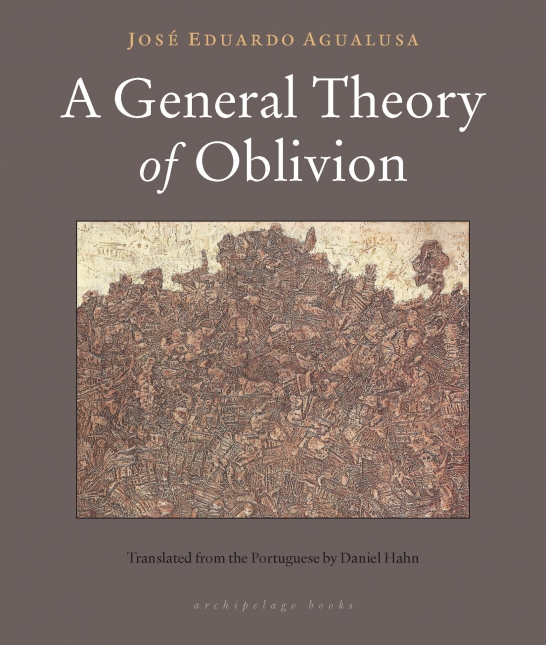A General Theory of Oblivion
- By José Eduardo Agualusa; translated by Daniel Hahn
- Archipelago Books
- 247 pp.
- Reviewed by Jennifer Bort Yacovissi
- January 5, 2016
A fever dream plays out amid the chaos of Angolan independence.

For American readers not already familiar with author José Eduardo Agualusa, and whose understanding of Portuguese colonialism is perhaps somewhat vague, A General Theory of Oblivion is a sneaky bit of a history lesson.
Portugal, which was comparable to England in the scope and length of its colonial reach, landed in what is now the southwest coastal African country of Angola in 1483 and didn’t cede control until 1975. Hence, it really shouldn’t be surprising that Agualusa is a white, native Angolan who writes in Portuguese.
That he writes with such an empathetic, race-neutral view of the struggle for Angolan independence won’t be surprising to those who have read some of his earlier works, such as The Book of Chameleons or Rainy Season.
At the center of Theory is Ludovica Fernandes Mano — Ludo — a native of Portugal with longstanding agoraphobia. “When still only a little girl, she was horrified by open spaces. She felt, upon leaving the house, fragile and vulnerable, like a turtle whose shell had been torn off.” An incident she thinks of simply as “The Accident” cements her unwillingness to venture outdoors.
After their parents die, she lives with her sister, Odette. When Orlando, a visiting Angolan mining engineer, falls in love with Odette, he realizes it is a package deal. He brings both sisters with him to live in the Angolan capital of Luanda, in a huge luxury apartment with a private rooftop veranda and a vast library.
Normalcy begins to erode as the long-simmering conflict for Angolan independence comes to a boil. Odette wants to join the many well-off Angolans who decide that Brazil or Portugal is more to their liking, but the day that Orlando finally agrees, he and Odette never return home from a farewell party.
Three things happen in quick succession: armed fighting breaks out in the streets below; a phone caller demands “the stones” in return for her sister; and Ludo accidentally kills one young man in a group of scavengers about to break into the apartment. After that, she methodically builds a brick wall outside her door that cuts the apartment off from the rest of the building and Ludo from the rest of the world.
From the foreword and acknowledgements, we learn that Ludo was a real person who bricked herself into her apartment for 28 years, writing diaries in notebooks until she ran out of paper and began to write on the apartment walls.
The book’s title comes from something the fictional Ludo writes: “If I still had the space, charcoal, and available walls, I could compose a great work about forgetting: a general theory of oblivion.” But the book might also have been named for one of the chapters, “The Subtle Architecture of Chance,” because at the heart of this story is the concept that chance choreographs so much of what our lives become.
Ludo peeks out at the world around and below her, watching incidents unfold that we see closer up and so make better sense of. Her world shrinks along with her food supply and eventually her vision. Survival comes to depend on burning books and furniture for cooking and heating, raising crops and collecting rainwater in the rooftop gardens, and learning to trap pigeons.
This last is made easier when Ludo finally finds the cache of diamonds hidden in the apartment and realizes the sparkle is just the thing to lure in the birds. Thus, in Ludo’s world, are pigeons worth far more than diamonds.
Interspersed with what sometimes feels like a fever dream of Ludo’s survival inside her castle walls are the swirling stories of the people and events in the streets and halls just outside. The tales may seem random and disconnected, but Agualusa is a master storyteller who doesn’t bother to introduce a character or mention an incident unless it has a larger role to play.
In one small instance, Ludo releases one of the captured pigeons, even though it has swallowed some of the diamonds, because it carries a love note in a cylinder on its leg. That act affects the lives of many of the characters we meet.
And those characters are never cardboard. For example, Jeremias Carrasco (which means executioner), a Portuguese mercenary with a taste for torture, squares off against Magno Mireira Monte, an intelligence officer of the communist MPLA faction who does his own share of inflicting pain, and yet each man eventually reveals a measure of humanity that lifts him out of simple villainy.
Agualusa originally wrote this story as a screenplay, and the novel retains that sense of immediacy. Certainly his economy of words heightens its impact. (The page count is deceptive: this is a tiny book with lots of white space, easily consumed in one long sitting.)
It’s a tribute to Agualusa’s storytelling that the bittersweet redemption found by his characters feels authentic; he and they have earned it.
Jennifer Bort Yacovissi’s debut novel, Up the Hill to Home, tells the story of four generations of a family in Washington, DC, between the Civil War and the Great Depression. Jenny is a member of PEN/American and the National Book Critics’ Circle, and reviews regularly for both the Independent and the Historical Novels Review of the Historical Novel Society. She is also president of the Annapolis chapter of the Maryland Writers’ Association.
_80_121.png)
